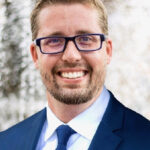Tensions escalate during Aquatic Center Subcommittee meeting; district proposes operating lap pool
- Home
- Tensions escalate during Aquatic Center Subcommittee meeting; district proposes operating lap pool
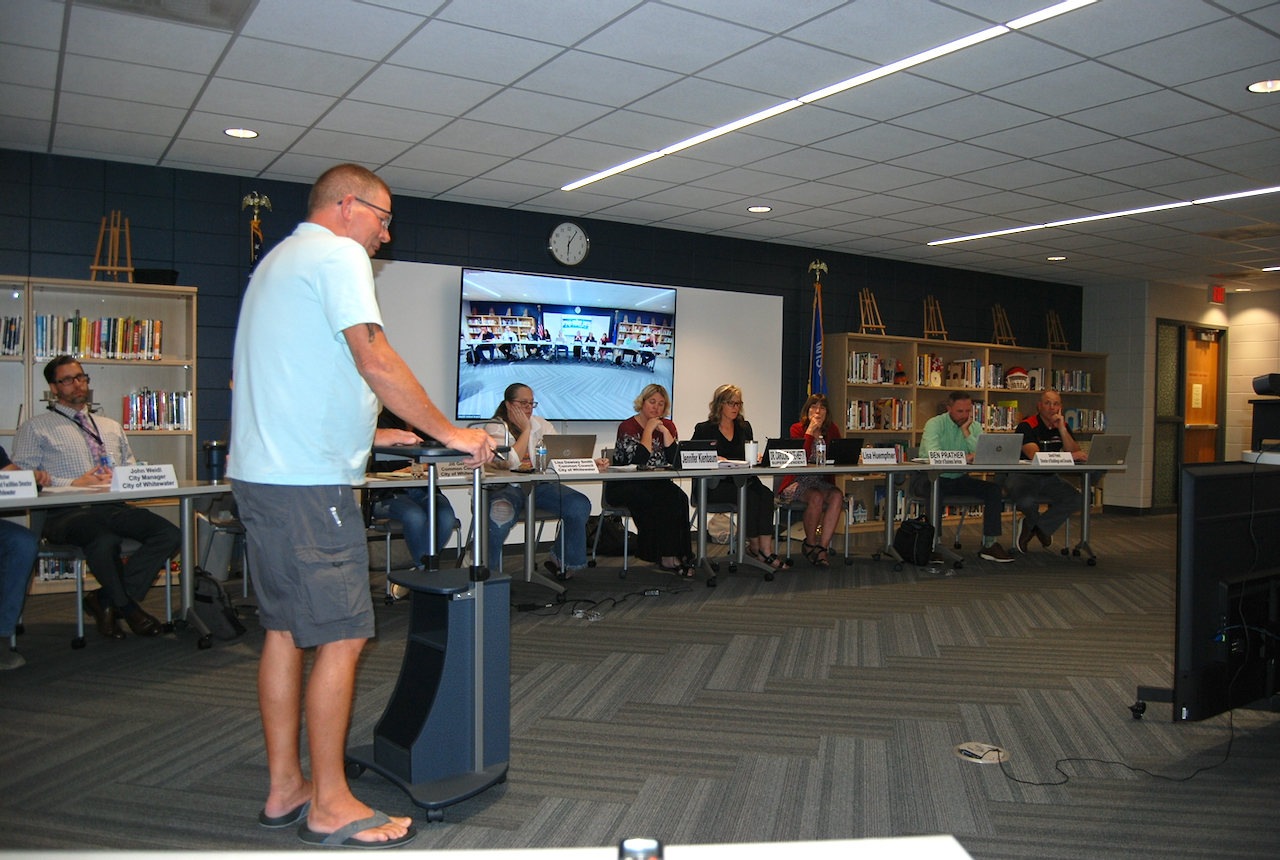
Tensions escalate during Aquatic Center Subcommittee meeting; district proposes operating lap pool
By Kim McDarison
A two-part meeting of the Whitewater Aquatic and Fitness Center Subcommittee Wednesday was characterized by heightening tensions between the two negotiating entities — the school district and the city.
Discussions between the entities intensified as subcommittee members grappled with two proposals, one offered by each entity, for aquatic center operations and capital improvement expenditures.
During the meeting, which was held in the library at the Whitewater High School, subcommittee members learned about a new proposal offered by the district, indicating its desire to assume operational responsibilities for the center’s lap pool, leaving the operations of the leisure pool and the fitness center with the city. The agreement further proposed that the district would become responsible for maintenance and repair to the center’s roof over the lap pool and its utilities room, along with any maintenance to the center’s parking lot, while the city would become responsible for the roof over the center’s leisure pool and fitness center.
At the onset, tensions flared over issues concerning agenda items, which stemmed from confusion about which of two agendas — one created by the city and one created by the district — would be used to guide the meeting, and, as the meeting progressed, during discussion about whether high school students could be allowed to visit the aquatic center’s concession stand during their scheduled lunch periods.
As frustrations became more apparent, City Council President Jim Allen, who also serves on the subcommittee, asked if the tables at which the subcommittee members sat could be reconfigured from a dais-style, with subcommittee members facing the audience, to a configuration more consistent with that found in a conference room, with subcommittee members facing one another. Additionally, he asked district and city support staff members, including Whitewater City Manager John Weidl and the city’s Parks and Recreation Director Eric Boettcher, along with Whitewater Unified School District Superintendent Caroline Pate-Hefty and the district’s director of buildings and grounds, David Friend, and finance director Ben Prather, to disengage from the discussion and find seating in the gallery along with members of the public.
With tables reconfigured, a second half of the meeting proceeded, with discussion continuing between Allen, and council members Lisa Dawsey Smith and Jill Gerber, and board of education members Jennifer Kienbaum, who served Wednesday as subcommittee chairperson, and Lisa Huempfner. A third board member, Miguel Aranda, was not in attendance.
While Allen assured those in attendance that the meeting, as posted on both agendas, would remain open, those seated in the room could not hear the conversation conducted during the meeting’s second half, and recording equipment provided by the district produced audio that was difficult to understand. In accordance with open meeting laws, Fort Atkinson Online also made an audio recording of the full meeting.
Some 15 people were in attendance as audience members, including Whitewater Unified School District Board of Education President Larry Kachel and board member Stephanie Hicks, and Whitewater Common Council member, David Stone, along with several members of a community-organized group called: “Save the Pool,” including Jeff Knight and Geoff Hale.
Disagreement arose early in the meeting after audience members became confused about which agenda — one submitted by the city and one submitted by the school district — would guide the meeting. Kienbaum told those in attendance that the meeting would follow an agenda as submitted by the school district because the meeting was being held in a building owned by the district. Members of the public objected, suggesting, instead, that an agenda submitted by the city was more appropriate because it offered more opportunities for public comments.
One commenter noted that the city’s agenda was published on an online community website, making it more available to residents than the district’s agenda.
Kienbaum asked the district’s Administrative Assistant to the Superintendent Jaclyn Tueting to make meeting attendees aware of where the district’s agenda had been published. Tueting said the agenda had been published in the district’s official newspaper, which, she said, is the Whitewater Register.
Public comments
Kienbaum, opening the floor at the top of the meeting to public comments, told those in attendance that the agenda section would be the only opportunity during which members of the public would be allowed to speak.
Hale pointed to a format used as part of the city’s open meeting process which offered additional opportunities for public comment.
He asked: “Are we allowed a rebuttal if we don’t like what happens tonight?”
Pate-Hefty told Hale he would not be afforded that opportunity during Wednesday’s meeting.
“This is a meeting of the school board, so this will be the only section in which public comments can be made,” Kienbaum said.
Also, as a matter of process, printed on the city’s agenda and read as a motion by Dawsey Smith, subcommittee members representing the city were asked to waive a 72-hour notice required by the city’s transparency ordinance.
Weidl noted that the motion was required because the city had not received some documents from the school board in time to publish them 72 hours before the meeting. City representatives on the subcommittee unanimously approved the motion.
Frustrations escalated over whether to allow public comments beyond the single opportunity provided on the district’s agenda.
Allen cited the “joint” nature of the meeting, further noting that the city’s process would allow additional comments.
Kienbaum asked members of the public to sign in and come to the podium.
Arriving at the podium, Whitewater resident Chuck Mills said: “I’ve never seen so much division from the school board and the council, and the general public.”
Mills said he had been trying to determine why, by his understanding, a “$50,000 deficit per year in the last five or six years” would have an impact that might cause the community to “give up the pool.” He described the pool as costing “$20 million to build,” and worth, by his estimation, “$50 million” would the community try to build the same facility today.
He alleged that some people might be speculating that turning the facility into a daycare center might look like a “cash cow.”
He said, by his calculation, some “2,000 people in this community” use the pool, and that finding $50,000 a year to offset what he saw as the deficit was something the community needed to resolve, adding: “it’s nothing we couldn’t overcome. We built the thing to begin with and let me remind you, it is our pool. It’s not the school system’s pool; it’s the public’s pool. So we need to, as the public, not let them take this facility from us.”
Addressing subcommittee members, Hale said he would make his comments at a later section within the agenda.
Discussion ensued about whether he would be offered another opportunity to speak.
Allen said he didn’t have an issue with allowing comments further down in the agenda.
Kienbaum said the district’s agenda was not the same as the city’s.
“This is our agenda for our meetings in our facilities. We follow their (city council member’s) rules when we are at their location and they are running the meeting. I’m sorry,” she said.
Directing his comments at school board representatives, Hale said: “That’s why this is so screwed up; this whole thing is so screwed up.”
Knight also addressed the subcommittee, saying: “I just wanted to highlight probably one of my bigger concerns is the lack of communication between the school board and the city. This is the agenda that was posted, this is the one that we got” he said of the city’s agenda. “We don’t get a mail from you Jen (Kienbaum),” he added.
City, district proposals
The subcommittee next reviewed proposals as submitted by the city and the school district to operate the aquatic facility. Offering a recap, Weidl said the city’s proposal called for a four-year agreement between the city and the district, calling for each entity to earmark $219,000 for facility operations in 2024, with that number increasing by 3% in subsequent years of the contract. The proposal also called for each entity to set aside $70,000 for a combined total of $140,000 for capital expenditures. In addition, the city would take responsibility for any operational deficits moving forward.
Weidl called the proposal a “starting point,” noting that he believed the council’s objective was to create a “multi-year agreement” that would support “the service levels and hours as they exist.
“We want to do that in a shared way, both on the risk side and the payment side,” he said, adding that $219,000 represented a $40,000 increase from last year.
Kienbaum confirmed that the total ask by the city from the school district for operational and capital expenditures at the center in 2024 would be $289,000.
Weidl agreed with her calculation.
She pointed to an earlier calculation made by the city in which a total cost to operate the lap pool was calculated at $370,472.
Weidl agreed the earlier number was high, saying: “We found an error.”
A new memo, he said, noted a figure of $326,000 to operate the lap pool.
Kienbaum said the district was interested in making a proposal in which it would only become responsible for the lap pool.
Said Kienbaum: “We will be 100% responsible for all costs incurred, we will have it separately metered so we will be able to ensure the cost of utilities are accurate, we’ll be responsible for all the maintenance and upkeep of it, we’ll separate out the boilers, we’ll be responsible for the roof over the top and you guys can take over the leisure pool and the fitness center. And then I believe if you are taking your $326,000, minus the $289 that you would expect from us on an annual basis, that would be a difference of about $37,000. We would just ask that that could be applied to the deficit for the past year that’s been incurring.”
Dawsey Smith asked if the district’s proposal would continue to make the lap pool available to members of the Whitewater Aquatic and Fitness Center.
Said Kienbaum: “As long as you guys have a membership and you want to use it, we would then work on an agreement where, yes, the individuals that currently have memberships could continue to use it.”
Gerber asked what the outcome for the public would be if the city opted not to provide access to the lap pool as part of its offered memberships.
Kienbaum said the district would discuss and decide what it might offer to the public.
Gerber asked about such services as fee collections for memberships, staff to greet members and provide towels. She wondered if the city would continue to provide those services and if it would be compensated.
Kienbaum said those details would need to be worked out, but, she said, she hoped the city would want to “work out a negotiated arrangement” through which it could continue to “use those facilities.”
Said Gerber: “How would we sell memberships if we don’t have control of the hours of when it’s available, to set hours for people, and if you start cutting in more into the programming, and then you remove it to the public, how are we going to sell memberships? Part of us selling memberships is fees to the lap pool.”
“It’s not our intention to cut into those hours,” Keinbaum said, adding: “It’s no different than us utilizing your facility during summer school or swim team … it would just be kind of a reverse.”
Allen asked who would staff the lap pool.
Kienbaum said the district would staff the pool while it was open for its swim team and summer school use, but during other hours of operation, when the district was not using the lap pool, the city would need to provide staff, including lifeguards.
Gerber asked why the city, as an entity that is leasing the space, would be interested in paying for the repairs to any portion of the building’s roof.
“It’s your roof. Why should we pay for it?” she asked.
“Because we are taking on over $300,000 in risk,” Pate-Hefty said.
“But you wanted the pool, so take the pool, and let’s say we are not going to do any memberships or open it to the public. So it’s your pool, its completely your roof,” Gerber said.
Friend said to maintain the pool facilities, the rent charged to the city, which, he noted, was $1, would need to increase.
“So we are in the same spot. We can’t agree,” Gerber said.
She added: “Your choice of taking on the pool affects our memberships, again, which affects us hiring people, us hiring lifeguards, and we are in the same spot, it’s just you’re controlling the hours of the lap pool and how much access we have.”
Pate-Hefty said the city would be provided with the same number of hours it currently has.
“There’s no limitations,” she said.
Huempfner said a goal of the board was to simplify the agreement.
“I think it makes a lot of sense for the public as well if you look at it this way. Neither of us wants to have to go to referendum,” she said.
“We don’t have to,” Weidl said.
Said Huempfner: “We need to provide for education, and the lap pool presents that piece for us. That is the biggest piece toward education (and) then the summer school programming, which we would figure out an agreement with you to rent your space for our summer school program, but I think that this simplifies it for the public. The public can see that more clear, and to me, as a community member, it’s more clear that the part that is more of a community service is the waterpark/leisure pool, and the fitness center, and the part that is more of the academic piece for the school district, if it gets divided this way, it just makes sense. Your numbers show that we have the greater cost.”
Expressing some frustration, Allen said “I came into this (negotiation) assuming, wanting to stop the ‘us, them’ ok?” He added: “And yet, every time we come to a negotiation with you, you don’t even address our concerns or our proposals, and we are back to debating yours. I don’t see a real give and take here. And I’m not criticizing the voting members.”
Kienbaum said the district was “trying to make it abundantly clear” that it was not “in the business of running a leisure pool or a fitness center.”
The district was providing proposals focused on its support of capital expenditures because, she said, “it is our building and we do have sufficient staff that are trained that could adequately maintain it.”
Weidl said he didn’t believe either entity was in “the business of anything,” citing both as nonprofit organizations. He defined both as service-based, and characterized the negotiations as becoming “extremely transactional,” further defining the aquatic center as “something that was fundraised for and developed to be transformational.”
He suggested the body should “stop worrying so much about who’s paying for what,” and instead “focus on services we are providing.”
Kienbaum expressed concern over what she described as the board’s inability to have control over day-to-day operations of the facility, pointing, additionally, to her concern about weekends during which the pool was closed.
On the capital improvement side, Kienbaum said the city was not providing adequate documentation about how capital funds were being spent.
“At the end of every year, I don’t know what happens to it. I don’t know if you are putting it in a rainy day fund or — so I guess there’s a lot of concerns by the board as to capital and what it’s going to be used for — the upkeep of maintenance, because we haven’t seen it in the past, and I think that’s where our first proposal was coming from is we want to make sure that’s getting done and it’s getting done correctly,” she said.
Weidl said perhaps the city council would be open to allowing the school district to hold onto the monies set aside by both organizations for capital improvements.
Subcommittee members agreed to a contractual term of four years.
Also included in the district’s proposal was a desire on the district’s part to survey the community about the pool.
Pate-Hefty said the survey would include questions beyond those associated with the pool and would likely be conducted by a third party.
Kienbaum said a “driving factor” of the survey was to learn from the public, whether, would the district accept any of the city’s proposals, it would be behind any associated increases in taxes.
Concessions
Allen noted that the city would be interested in seeing concession sales made available to high school students at lunchtime.
Said Pate Hefty: “Closing concessions is an administrative determination, not a board-level determination.”
She noted that during COVID, the Wisconsin Department of Public Instruction was looking to separate students at lunchtime. With 100 to 150 students in the high school cafeteria during a single period, Pate-Hefty said the district allowed students to go off campus for lunch. During that time, she said, “we had two serious accidents,” and, she noted, attendance rates were “significantly impacted following lunchtimes.”
Pate-Hefty said the district consulted its insurance carrier and other schools within the Rock Valley conference before deciding to close campus during lunchtime.
Additionally, she said, in September, 2022, the federal provisions for free and reduced lunch “reactivated.”
She said that would the district allow the sales of foods that were not federally approved, it would risk losing funding for its free and reduced meal program.
Foods sold at the center’s concession stand are not approved, she said.
Discussion ensued around how the concession stand at the aquatic center was defined.
With the stand defined as an off-campus site, Weidl said, “a pen stroke” on the part of the superintendent could allow the students to visit the aquatic center.
“You could, literally, if you wanted to, as the administrator, say we are not allowing off campus lunches, except for this one place, which is right here, down a hallway, and we would both comply with the federal guidelines, plus the WAFC would be allowed to sell concessions,” he said.
“And what we are telling you is that we can’t and won’t sacrifice safety …” Pate-Hefty said.
She said the decision to close campus was made by a leadership team, including herself, and the high school principal.
“I support and back it, and it will not be changed,” she said.
Said Weidl: “It’s down the hallway. You have cameras. There’s a cop in the building.”
Pate-Hefty said there was not a camera in the hallway adjoining the center to the school, and additional safety issues were present because students might have to walk past the pool.
Weidl said the city would install a camera.
“You’re undermining the necessary supervision that needs to occur for students,” Pate-Hefty said, adding: “my job and the high school principal and leadership team’s job is to make sure kids are safe, that is not your call.”
Kienbaum suggested the city consider selling concessions to students before and after school.
Gerber said she was concerned about labels associated with the concession stand, noting that sometimes the district calls it an on-campus facility, in which case it would need to follow rules about federally approved foods so the school is in compliance with free and reduced meal guidelines, while other times, the district labels the stand as off-campus, which eliminates a need to be within federal guidelines about foods, but makes the site a safety concern.
She noted that visiting the stand did not require getting into a car, nor did students need to walk past the pool.
“We are willing to comply with things that provide another option for students to have lunch,” she said, adding: “We are either on campus or we are off campus, so you confuse me each time you say we are or aren’t.”
Kienbaum suggested the city consider a cart that could be brought to the cafeteria during lunchtime from which the students could purchase foods sold by the stand.
Weidl said the city would be willing to address issues of food compliance and safety.
Said Pate-Hefty: “For $9,000,” the amount, she said, the city cited as income it could make from selling snacks at lunchtime, “you cannot address our students’ safety — ever. I won’t ever put our kids at risk for that. I’m not going to put a kid down a back hallway, walking across a pool, so that they can get a snack … I would encourage you to look at your business model, and look at other options. And we’re glad to help you with other options if you need ideas, because that’s what businesses do when things change.”
Pate-Hefty called the $9,000 figure “contrived,” noting that is was based on “hours in a day” rather than calculated through “POS” (point of sales).
Subcommittee members discussed the possibility of the aquatic center selling concessions during school dances and other events.
Weidl said the district was making a decision without giving any consideration to the city’s ask.
City’s action plan
Boettcher next offered a brief presentation recapping the city’s action plan to improve memberships.
Among challenges, he said, was hiring more lifeguards.
He noted plans to create training opportunities for lifeguards in conjunction with the school district through a lifeguard training class.
In addition, he was working with the Friends of the Whitewater Aquatic Center group to provide an incentive program for those taking training classes and signing up to work “a certain number of hours” for the city, he said.
He hoped to have staff “built up” in the next one to three months, he said.
The city also has set a goal of signing up 40 new annual members over the next year.
Kienbaum suggested the city consider contacting communities with outdoor pools to see if their lifeguards would be interested in picking up more hours when cooler weather arrived, closing their pools for the season.
Boettcher agreed that was a good idea.
Weidl said the city also hoped to be able to offer over time a more competitive wage to attract lifeguards. Currently the city pays between $13 and $16 an hour for lifeguards.
“Our average needs to be more like $15 an hour,” he said.
Weidl said he was taking the lifeguard training so he could offer his services on weekends. He called the situation one of “all hands on deck.”
Whitewater Aquatic and Fitness Center Manager Lorelei Bowen, who was among members of the audience, was invited by the panel to talk about new ideas for the center.
She said she, Weidl and Boettcher had visited the YMCA in Janesville and were exploring such ideas as virtual fitness, which would allow members to participate in a fitness program virtually from a location of their choosing at a time of their choosing.
The option could be provided without additional staff, but would require some equipment like a screen and lighting, she said.
Kienbaum suggested the city consider making use of the district’s mailing list as a means through which to communicate with the district’s families. She also suggested the city create a program that could be included in the district’s employee handbook, offering a “discount or benefit” to district employees.
“So, if it’s all hands on deck and we’re really trying to push this, then I guess we’d like to see a little bit more information so that we can make sure it’s getting marketed,” Kienbaum said.
Discussion excluding support staff
During the second half of the meeting, subcommittee members moved their chairs together so they could have, according to Allen, “a quick, frank discussion before we move forward. I think we are close, I’m not asking anybody to leave, just leave the space, stay in the room, but we might be able to get some things accomplished rather than waiting for another month.”
Said Pate-Hefty: “How are you doing that and continuing to have a public meeting?”
Allen said he would ask support staff to “step away,” leaving the voting members to continue a conversation.
“Everyone else can hear us,” he said.
During the ensuing discussion, Gerber said she was interested in opening a babysitting room at the aquatic center.
“I just don’t know how that would work with insurances,” she said.
“You’ve got amazing ideas, and I feel like I have great ideas, but none of us are doing the day-to-day operations. I’m not making sure the door’s open,” Kienbaum said. She described the board’s view of operations as one from 30,000 feet.
She said the board did not want to meddle, but there were issues.
Said Gerber: “You had a say, you just didn’t take advantage of it.”
She said mistakes were made by prior boards and councils, and that the Park and Recreation Board, which has oversight of the center, has two school district representatives. The individuals just needed to show up and speak up, Gerber said.
Kienbaum asked if the Park and Recreation Board was in charge of hiring and firing.
Gerber said it was not. The responsibility of hiring and firing rests with the city manager.
“They can recommend, they can say they are not happy with the things that are not happening, but John (Weidl) ultimately has the power to hire and fire,” Gerber said.
Kienbaum said she has brought friends from out of town to the aquatic center on weekends and found it closed.
Allen said the city needed more staff.
Kienbaum said that she would like to see more accountability.
She said the district had concerns about accountability and capital expenditures.
Gerber said she was supportive of the district taking on the responsibilities of capital expenditures.
“I consider it your building anyway, so if you want to control the capital, I don’t have a problem, but the same thing, I think it has to go through the Park and Rec Board with your two members and just get approval from the Park and Rec Board. That way, we both have a say,” she said.
Kienbaum stressed the board’s desire to keep the capital improvements money in a district fund.
Gerber responded by saying, “fine.
“We just need to make sure that that Park and Rec Board is an active body and the aquatic center stays on a monthly agenda every time it’s there. And when you have two people assigned, they need to be present or send people in their place.”
Said Kienbaum: “I can probably get the board to come to an agreement if we could contribute more in capital than operations, because for our constituents, it’s our building and it’s an easier sell for us to be able to say it’s our building, it’s our equipment, as opposed to we’re running a leisure pool and a fitness center.”
Subcommittee members talked about the value of the lap pool as an academic component.
“Our phy-ed classes can now use it year-round,” Kienbaum said.
“Your phy-ed classes could incorporate our leisure pool or our fitness center, too,” Gerber said.
Along with athletic program benefits, Gerber said the fitness center offers opportunities to students who are not necessarily involved in athletics.
“You are incorporating a group of kids that aren’t being supplied by your school district by having our fitness center attached,” she said.
She added: “Keep in mind, you’re looking for open enrollment. Your leisure pool is pulling in people from East Troy, Elkhorn, Fort Atkinson, you’re missing the opportunity to hit them up for open enrollment and showing your school. They are coming here, they see your school, they see your facility, so it does serve a purpose. You may not need the leisure pool for your students, but it serves for your open enrollment and also marketing on your end. And attracting teachers.”
Gerber asked Kienbaum for a dollar amount with which the district would be comfortable as its contribution to the center’s operating costs.
Kienbaum asked Prather to join the conversation.
“There’s a threshold where we cross a certain amount, we then are guaranteed to raise taxes on our constituents, and we can’t cross it,” Kienbaum said.
Gerber said that splitting the costs as proposed by the city was likely the least expensive option for both entities.
When asked if the city’s ask of $289,000 would cause the district to need to raise taxes, Prather said: “It’s a huge calculation.”
He asked: “Is the overall number changing? If the overall number is not changing, we are going from $178(,000) right now to $289(,000), then yes, it would increase, but with tax formulas, there are so many variables, there’s how many students, the Legislature, because the Legislature hasn’t passed a budget, and so I told (former City of Whitewater Finance Director) Steve (Hatton) this … I said: ‘hey, don’t tie yourself to our assumptions because our assumptions aren’t final until November.’
“So just simple math would be that we’re increasing through our Fund 80 levy from what it was. … so it would be an increase. Maybe our student count decreases, which could offset that, but right now the state is looking to kick in over $300 onto the revenue limit, the tax formula per kid.”
Prather continued: “I don’t know if the rationale was ever shared, I’m thinking over the last pool overall costs, … we hired a new maintenance guy who’s skilled in pools that we thought we could bring that maintenance cost down running the lap pool. That’s why we’re willing to swallow a little bit more up front toward the longterm goal.”
Prather said he could “run an estimate,” but his budget was tied to the state budget. He said he could create estimates based on enrollment numbers which will become known to the district in September, further noting that the district will create an “actual budget” in October.
Whatever the solution, Kienbaum said, it could not bring higher taxes to the district’s constituents.
From the district’s perspective, she said, the plan was for the maintenance person to become a certified plumber and he was taking courses for pools. He then could help reduce costs, which, she said, is why the district is interested in taking on more of the maintenance expenses.
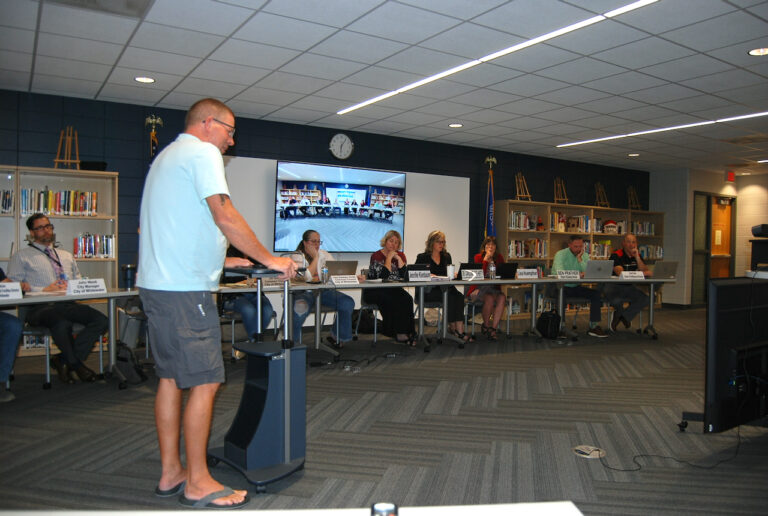
Members of the Whitewater Aquatic and Fitness Center Subcommittee assemble Wednesday at the Whitewater High School library. The committee began its meeting assembled in a dais configuration in front of its audience. Chuck Mills, a Whitewater resident, was among four speakers arriving at the podium during public comments.
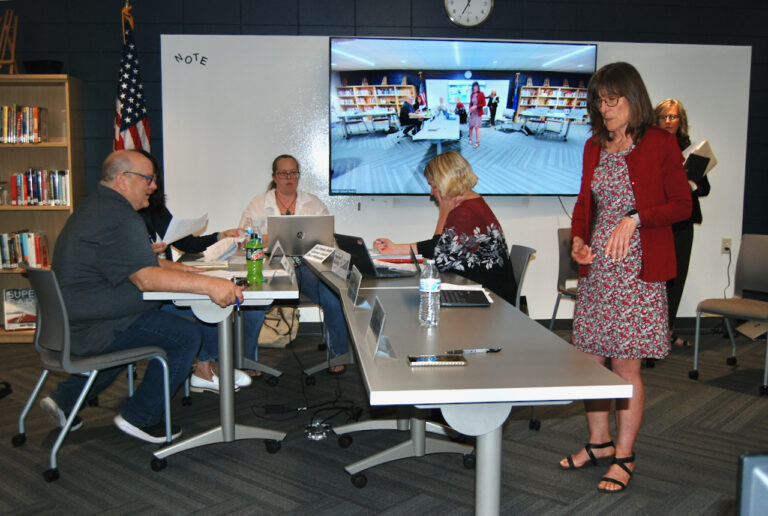
At the request of aquatic center subcommittee member Jim Allen, at left, aquatic center subcommittee members rearrange their tables into a configuration similar to one found in a conference room. Remaining at the table are Whitewater Common Councilwoman Jill Gerber, pictured behind Allen, Whitewater Common Councilwoman Lisa Dawsey Smith, following Allen, from left, Whitewater Unified School District Board of Education member Jennifer Kienbaum and Whitewater Unified School District Board of Education member Lisa Huempfner. Supporting staff members formerly seated at the dais were asked to leave the discussion table.
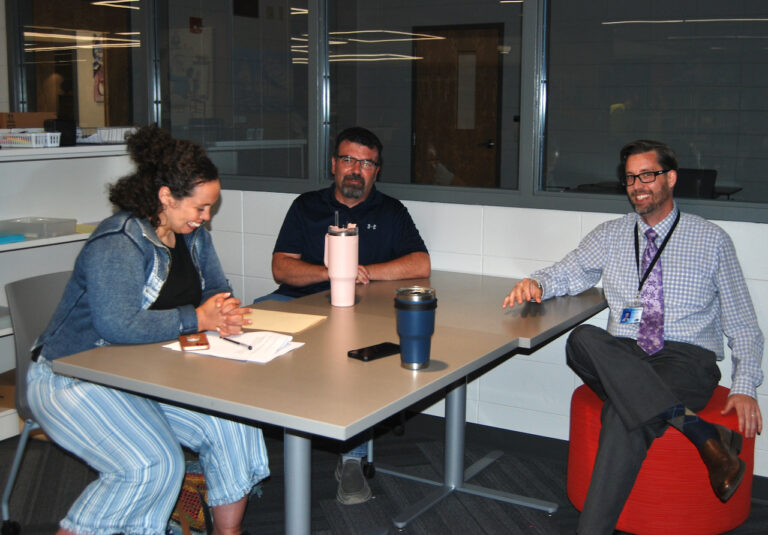
Whitewater Aquatic and Fitness Center Manager Lorelei Bowen, from left, Whitewater Parks and Recreation Director Eric Boettcher and Whitewater City Manager John Weidl find seats in the audience after being asked to disengage from discussion during the Whitewater Aquatic and Fitness Center subcommittee meeting.
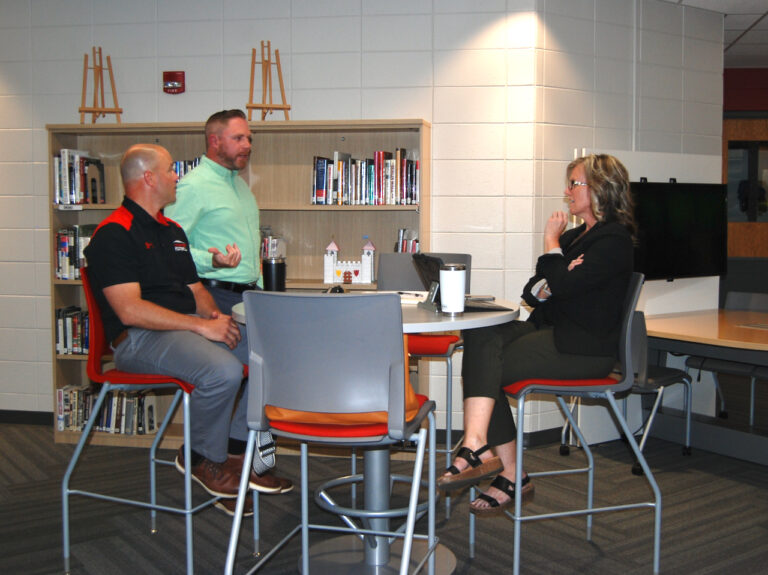
Whitewater Unified School District Director of Buildings and Grounds David Friend, from left, district Finance Director Ben Prather and district Superintendent Caroline Pate-Hefty find seats in the audience after being asked to disengage from discussion during the Whitewater Aquatic and Fitness Center subcommittee meeting.
Kim McDarison photos.
This post has already been read 337 times!
Our Advertisers
Most Read Posts
Categories
- Advertisers
- Area events
- Art, culture
- Business
- Community
- County
- Crime, court
- Culture
- Diseases
- Economics
- Food
- Government
- International
- Law and Court
- Lifestyle
- Obituaries
- Opinion
- Police, fire, EMS
- Religion
- School
- Science
- Technology
- Today's features
- Today's news
- Top Stories
- Travel
- Uncategorized
- University
- World












